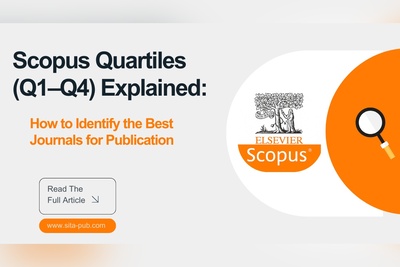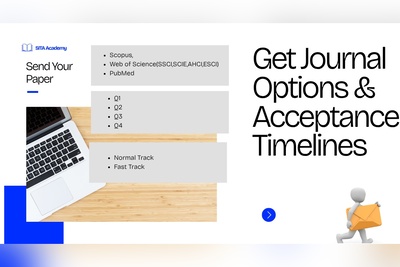How to Publish a Research Paper in Scopus Journals (Step-by-Step Guide)
Learn how to publish your paper in Scopus-indexed journals. A complete step-by-step guide for researchers, students, and faculty — from writing to acceptance.
- Step 1: Prepare a Ready Research Paper
- Step 2: If You Don’t Have a Ready Paper
- Step 3: Define Your Publication Goals
- Step 4: How to Find the Right Scopus-Indexed Journal
- Step 5: Check the Journal’s Quartile and Authenticity
- Step 6: Compare and Select the Best Journal
- Step 7: Format Your Paper According to Journal Guidelines
- Step 8: Submit Your Paper
- Step 9: Peer Review Process
- Step 10: Acceptance, Proof, and Publication

Publishing a research paper in a Scopus-indexed journal is one of the most important milestones for academics and researchers worldwide. Whether you’re a faculty member aiming for promotion, a PhD or master’s student preparing for graduation, or an independent researcher seeking visibility, Scopus publication gives your work credibility and international recognition.
Even research centers and universities depend on Scopus publications to improve their academic ranking and research impact.
If you’ve ever wondered how to publish a paper in a Scopus journal, this detailed guide will walk you through every step — from preparing your manuscript to seeing your paper accepted and indexed in Scopus.
Step 1: Prepare a Ready Research Paper
Before submitting anywhere, you must have a well-structured, original, and plagiarism-free research paper.
Structure of a Research Paper (for Scopus Submission)
Section | Description | Optimization Tips |
Title | Should clearly reflect your research focus. | Use 8–14 words including 2–3 Scopus-relevant keywords. |
Abstract | Concise summary of purpose, method, and results. | Keep 150–250 words; include indexing keywords. |
Keywords | 4–6 terms identifying your research field. | Match journal scope keywords for better discoverability. |
Introduction | Explains background, research gap, and aims. | Cite recent Scopus-indexed articles. |
Literature Review | Overview of related studies. | Highlight what’s missing in existing literature. |
Methodology | Detailed explanation of research design and tools. | Be transparent; reviewers value clarity. |
Results & Discussion | Data presentation and interpretation. | Use graphs and tables for visibility. |
Conclusion | Summarize key findings and implications. | Mention potential for future research. |
References | List all cited works. | Follow journal-specific style (APA, IEEE, etc.). |
Step 2: If You Don’t Have a Ready Paper
If you haven’t written a publishable article yet, don’t worry — there are two options:
Write your paper from scratch based on your latest research or data.
Extract papers from your Master’s or PhD thesis.
A thesis cannot be published directly in Scopus journals — it must be rewritten into article form.
Typically, a PhD thesis can yield 2–3 journal papers when properly restructured.
You may use article extraction services to identify extractable sections and rewrite them into separate publishable papers.
Step 3: Define Your Publication Goals
Understanding why you are publishing will determine where you publish.
Purpose | Recommended Journal Type |
Academic promotion | Scopus Q1–Q3 or Web of Science (WoS) journals |
Graduation | Scopus Q3/Q4 journal with moderate publication fee |
Fast publication | Fast-track Scopus journals |
Institutional ranking | Journals with high citation impact |
Knowing your goal, budget, and timeline helps narrow down journal choices effectively.
Step 4: How to Find the Right Scopus-Indexed Journal
Finding a Scopus-indexed journal that matches your topic is crucial. Here are the best ways:
1. Use the Scopus Source List
Visit Scopus Sources.
Search by subject, keyword, or ISSN.
Check whether the journal is “Active” in Scopus indexing.
2. Use Scimago Journal Rank (SJR)
Go to Scimago Journal Rankings.
Search your field and view the Quartile (Q1–Q4) ranking, country, and publisher.
3. Use Journal Finder Tools
Most publishers offer tools that recommend suitable journals based on your abstract:
4. Use Journal Recommendation Services
If you’re unsure, professional journal matching services (like SITA Publication Support) can analyze your paper and recommend Scopus-indexed journals with high acceptance rates and relevant scopes.
Step 5: Check the Journal’s Quartile and Authenticity
Before submitting, verify the journal’s quartile rank and avoid fake or predatory publishers.
Quartile | Quality Level | Suitable For |
Q1 | Top 25% | High-impact research, promotions, and citations |
Q2 | Strong | Balanced option for recognition and speed |
Q3 | Moderate | Suitable for fast publication or new researchers |
Q4 | Entry Level | Acceptable for thesis publication and early careers |
Always cross-check the journal’s name and ISSN on the official Scopus source list.
Step 6: Compare and Select the Best Journal
Journal Name | Scopus Quartile | Acceptance Time | Publication Fee | Subject Match | Notes |
Journal A | Q1 | 3–4 months | 1500€ | High | Excellent quality |
Journal B | Q3 | 2–3 weeks (Fast Track) | 900€ | Moderate | Good for deadlines |
Choose a journal that balances quality, affordability, and publication speed.
Step 7: Format Your Paper According to Journal Guidelines
Once your target journal is selected, visit its “Instructions for Authors” page and follow:
Word limit, font size, and margin rules.
Reference and citation style (APA, MLA, IEEE, etc.).
Number of figures/tables allowed.
Required documents (cover letter, ethics statement, etc.).
Pre-Submission Checklist
Item | Status |
Manuscript formatted correctly | |
Cover letter prepared |
|
ORCID ID and author details added |
|
Plagiarism check done (<15%) |
|
References verified |
|
Figures and tables labeled |
|
Step 8: Submit Your Paper
You’re now ready to submit your research paper to a Scopus journal.
Register on the journal’s submission portal.
Upload your manuscript, cover letter, and any required forms.
Double-check uploaded files before final submission.
You will receive an acknowledgment email confirming submission.
Step 9: Peer Review Process
Your paper enters the peer review stage, where experts evaluate its quality and originality.
Possible outcomes:
Minor revision: Small corrections requested.
Major revision: Significant improvements required.
Acceptance: Congratulations!
Rejection: Revise and submit to another Scopus-indexed journal.
Always respond to reviewer comments clearly, point-by-point, in a separate “Response to Reviewer” document.
Step 10: Acceptance, Proof, and Publication
Once your paper is accepted:
You will receive an official acceptance letter (useful for university requirements).
Then, you’ll review the galley proof — the final typeset version before publication.
After approval, your article will be published online with a DOI and indexed in Scopus within a few weeks.
Step 11: Share and Track Your Published Paper
After publication:
Share the publication link on your Google Scholar, ResearchGate, and LinkedIn profiles.
Track citations via Scopus Author Profile.
Add it to your academic CV and promotion file.
This visibility can lead to international collaborations, invitations, and funding opportunities.
Bonus Tips for Successful Scopus Publication
Avoid plagiarism — keep similarity under 15%.
Ensure all authors meet authorship criteria.
Check that your data is authentic and reproducible.
Always use a professional academic email (not Gmail/Yahoo) for correspondence.
Never submit the same paper to multiple journals simultaneously.
Final Thoughts
Publishing in Scopus journals is both a strategic and rewarding process. With a clear goal, a properly prepared paper, and the right journal choice, you can achieve successful publication — even as a first-time author.
Whether you’re a PhD student, professor, or independent researcher, following these steps will significantly improve your chances of Scopus publication success.
If you’d like expert help in:
Editing or rewriting your paper,
Extracting articles from your thesis,
Finding the most suitable Scopus journal, or
Submitting and communicating with editors,
the SITA Publication Support Team can guide you through the entire process professionally and efficiently.
Process of Submitting an Order in SITA Academy

Share Your Research Scope |

Receive Journal List |

Select Your Journal |

Formatting & Submission |







